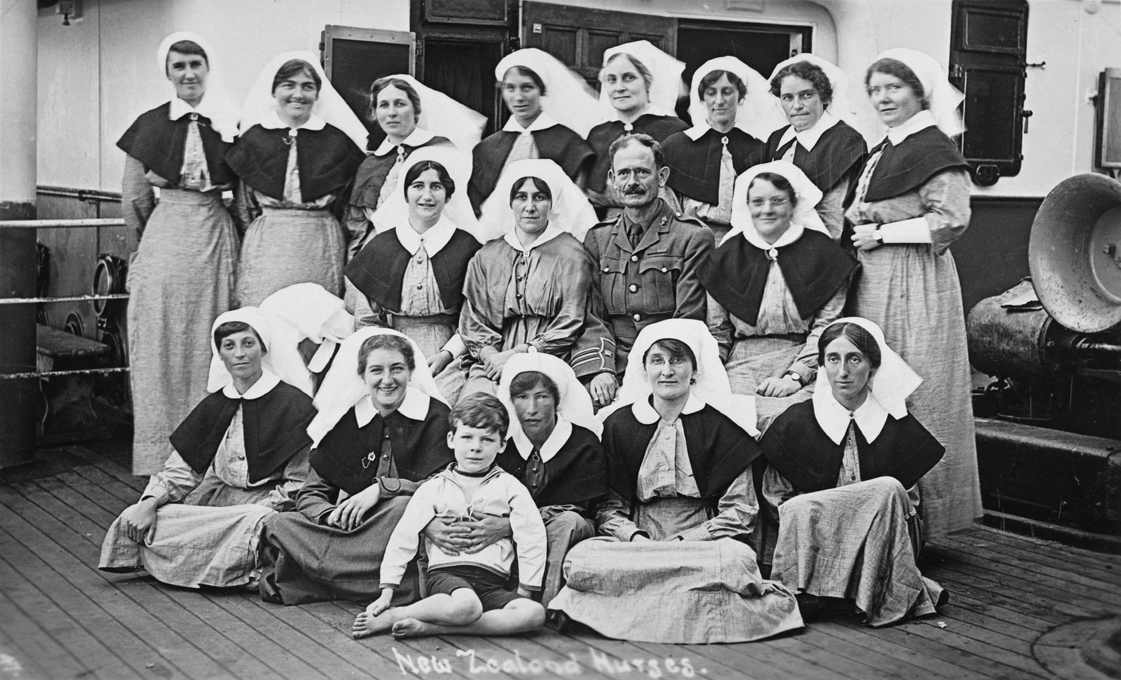WW1 Matron Emily Edwina (Beattie) Ross (22/401)
Emily Edwina Beattie was born on 16 April 1877 in Forest Hall, Tyne & Wear, England. She was the eldest of three daughters of Frances Beattie (Oliver) (1850 – 1883) and the Reverend Alexander Minty Beattie, (1835 – 1908).
The two other daughters were Olive Mary (Beattie) Tibbs (1881- 1947) and Frances Alexa Beattie (1883 – 1967). Their mother Frances appears to have died after the birth of Frances Alexa when Emily was 6 years old.
Reverend Beattie arrived from England in 1879 and was pastor of Ashburton Presbyterian Church until 1889. The Reverend Beattie married Mary Elizabeth Rutherford (nee Oliver), (1841 – 1939) in 1890 and three years later, the family moved from Ashburton to Patea. In 1901 they moved again to Mangere until he resigned because of ill health in 1904 and died four years later. The Reverend Beattie is regarded as one of the early Presbyterian Movement pioneers in New Zealand. [1, 2, 3, 4]
Emily trained as a nurse at the Patea Hospital from 1898 to 1900 and then spent 4 years at Wellington Hospital gaining her nursing certificate in 1902 and her midwifery certificate at St Helen’s in Auckland in 1906. She was a Sister at Auckland Hospital in 19112 and Matron at the Knox Bequest Home from 1912 to 1916. [5, 6] On the 30 December 1916, Emily began service with the New Zealand Army Nursing Service (NZANS) as a Staff Nurse, with the 20th Reinforcements, New Zealand Expeditionary Force. She was later promoted to a Matron. The nurses were transferred from England to France at the end of May 1917, when No. 1 New Zealand Stationary Hospital (NZSH) moved north to Hazebrouck, near Armentières.
No 1 NZSH was housed in the rounded economically constructed and portable Nissen huts. The hospital could take 800 patients initially, and later expanded to 1000. The area was very damp and swampy. Deep trenches had to be dug around the huts, with duckboards made of wooden slats to enable movement. The nurses suffered badly from chilblains and trench feet and were often ill.
Nursing was hard and unrelenting work. Casualties poured in, often straight from the trenches. Operations were performed without a break for up to 36 hours. As well as battle wounds, there were injuries from contact with the deadly mustard gas, and gas gangrene, caused by bacteria in the soil of northern France.
The New Zealand wounded and sick arriving in England were taken to hospitals at Walton, Brockenhurst. As the men recovered, they went to Hornchurch to convalesce and then to Codford to be ‘rendered fit again for service’. Many, of course, never fought again and were sent home to New Zealand on the hospital ships. [7]
Although armistice was declared on 11 November 1918, but nursing continued as there was an outbreak of influenza. The nurses were deeply distressed as men died of influenza after surviving years in the trenches.
On 22 May 1918, Emily married William Alexander Ross from Western Australia at St Luke’s Church, Remuera. [8] In 1919 Emily was living at 33 Maurice (now Mauranui) Road, Newmarket and from 1938 to 1949 she was living, widowed, at 45 Armadale Road Remuera.
For many years, Emily was the Honorary Treasurer of the Returned Army Nursing Sisters (RANS), an association established in 1928 for the benefit of the returned nursing sisters and to raise funds to help needy families of returned soldiers. [9]
Emily died in 1971 aged 94. She was cremated at Purewa Cemetery on 30 April 1971.
G Ralph
June 2020

